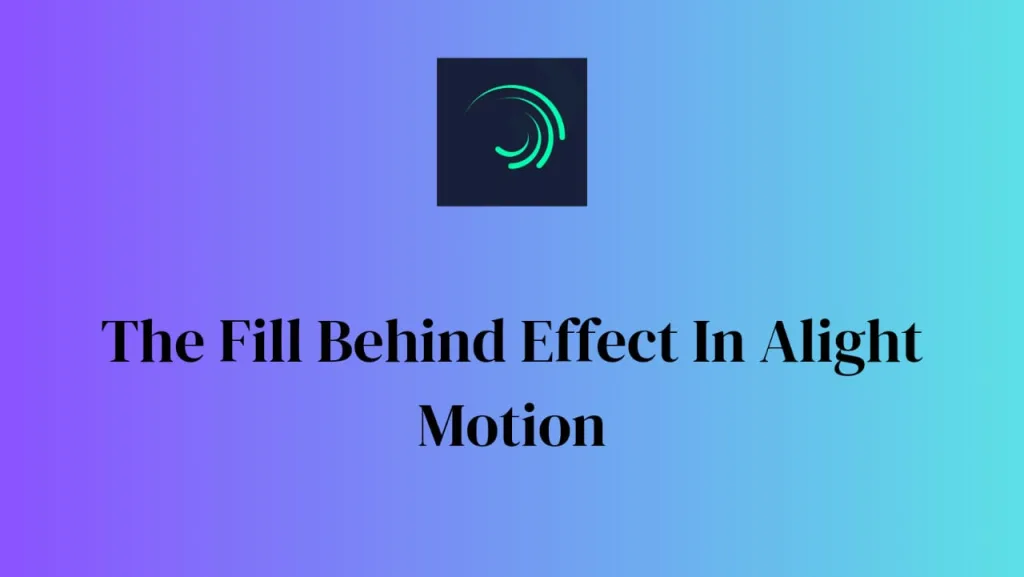A Full Guide On Using The Fill Behind Effect In Alight Motion

Intro
There are several effects available in Alight Motion to improve your pictures and films. The Fill Behind effect is one of the most adaptable.
This effect fills the background with a modified duplicate of the layer, allowing users to easily adjust their media to other aspect ratios or orientations. We’ll explore the characteristics, applications, and use cases of the Fill Behind effect in Alight Motion in this tutorial.
Comprehending the Properties
Power:
Range: 0 to 2; 0.3 is the default. Regulates how much of the background copy is blurred. Increasing Strength aids in preventing the translucent fringes that surround the screen’s edges.
Feather:
Range: 0 to 1; 0.05 is the default establishes how much feathering is present on the foreground’s edges. If Strength is zero, ignored.
Reaching saturation
Range: -100% to +100%; +0% is the default. Modifies the background copy’s color intensity. Positive values intensify color, whereas negative values desaturate it.
Vibrance:
Range: -100% to +100%; +0% is the default. Regulates the backdrop copy’s brightness. Positive values brighten while negative ones get darker.
Alpha:
Range: 0.01–9.99; 1 is the default. Applies gamma correction to the background copy’s luminance.
The FG and BG Alphas:
Range: 0%–100%; 100% is the default. Adjust the background and foreground copies’ opacities.
Color and Tint of Tint:
Strength and Count of Scan Lines:
Zero by default (disabled)
simulates the addition of scanlines to the backdrop copy.
BG Scale, BG Offset, FG Scale, and BG Offset:
By default, Scale is set to 1 and Offset to 0.
individually adjusts the size and position of the background and foreground copies.
Instructions for Use:
Implementing the Impact: Apply the Fill Behind effect to a layer in your picture or video. To get the appropriate backdrop style, adjust the settings.
Modifying the Properties: To get the correct look, play about with Strength, Feather, Saturation, and Brightness. To further customize, use Edge Strength and Tint.
Animation: While it is usually not required, keyframe animation can be used for transitions by applying it to the FG Offset and FG Scale. Subtle animation on the BG and FG scales can provide movement to still images.
Examining Presets: Presets are available in Alight Motion for quick background styles or as ideas for custom designs.
Use Cases:
Adjustment for Aspect Ratio: When using material that has a different aspect ratio than your project, fill the backdrop.
Vertical Video Conversion: For engaging backgrounds for vertical videos in square projects, use Fill Behind.
Changing Backgrounds: Use the effect to give the backdrops of your projects more depth and life.
Final Words
In conclusion, Alight Motion’s Fill Behind effect is an effective tool for adjusting material to various aspect ratios or orientations while improving the piece’s overall visual attractiveness. Users can easily design interesting backdrops for their projects by playing with customization choices and knowing its qualities.
The Fill Behind effect in Alight Motion provides countless opportunities for imaginative background designs or straightforward aspect ratio modifications.

![Why Alight Motion APK Crash [Complete Guide] 3 Why Alight Motion APK Crash?](https://img.thealightmotion.online/uploads/2023/11/Blue-and-Pink-Professional-Business-Strategy-Presentation_20231125_113501_0000-768x432.webp)

![Unlocking The Power Of The Unsharp Mask Effect [Full Guide] 5 unlocking the power of the unsharp mask effect](https://img.thealightmotion.online/uploads/2024/01/unlocking-the-power-of-the-unsharp-mask-effect-768x433.webp)


